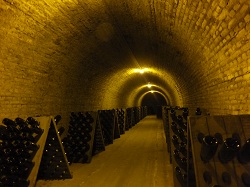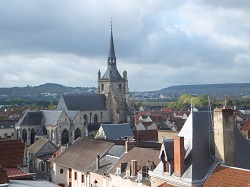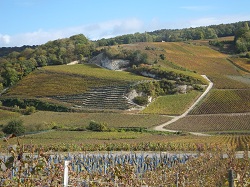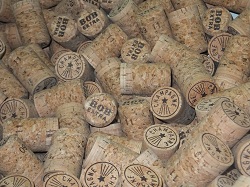Next stop on our gastronomic ‘Tour de France’ was Reims, in the heart of Champagne. Elisabeth, our hostess warned us when showing us the map: “This….this entire area is a…well….a restaurant desert….” A solid 5 hour drive from Saumur – which I am glad to report, although a “desert” culinary wise, was completely un-eventful.
I lie.
There was a slight situation, involving our GPS directing us down a narrow lane (theoretically en route to Tours), which ended at a large sign warning: DANGER DU MORT – TIR DE GUERRE. Roughly translated, ‘danger of dying, war practice’. No matter how many times the GPS (in a tone that implied – ‘why don’t these two ever listen to me?’) claimed to be re-calculating, we turned around post haste and headed back down the narrow lane. I did not even stop for a photo of the sign. We were not shot at by the French army – so I guess the drive really was uneventful.
Once in Reims – we started bumping into classmates from the Hautes Etudes de Gout class of 2010. It was great to see everyone, and we were all keen to get drinking some champagne to celebrate our successful completion of the course. That evening we returned to Le Boulingrin – a charming old school brasserie – where we indulged in classics, like os a moelle and steak tartar, with a few glasses of bubbly of course. If you ever find yourself in Reims, look for Boulingrin – it’s the real deal – waiters with long white aprons, a classic menu, and the place is full of locals. http://www.boulingrin.fr/page2.asp?rec=99
We managed to sneak in a couple of Champagne visits in Epernay the morning of graduation. Gosset is the oldest wine house in the Champagne district – founded in 1584. In the late 1500’s wine was still only available in barrels – it was not until the early 18th century that wine was placed in bottles. People started to notice that sometimes the wine had tiny bubbles….bubbles that were in fact very enjoyable. Winemakers wanted to avoid the bubbles at all costs as it rendered the bottle a virtual time-bomb. Dom Perignon actually spent most of his life trying to stop second fermentation in bottles – not creating it!

In the champagne region, the houses that produce 80% of the world’s champagne only own and cultivate 20% of the vines. Conversely, growers (and there are over 1,300 of them) produce 80% of the grapes and only 20% of the champagne. Gosset does not own any vines – they purchase juice from over 200 growers in the region – feeling that the closer the grapes are pressed to picking – the higher the quality will be.
We had a tour of the 1.5km of caves housing 4 million bottles of champagne at various stages of readiness. Gosset produces 1 million bottles per year and exports to over 80 countries. The cellar master – who has been with them for 27 years and who is known as “le memoire”, presides over the strict separation of grapes, keeping each village separate to allow for maximum flexibility during “assemblage” when the still wines (vins clair) are blended prior to being bottled and dosed with yeast and sugar for their second fermentation.

Only 7km away, Rene Geoffroy was an entirely different kettle of grapes. Here, they proudly declared, they make champagne the ancestral way. They own 14 hectares of grapes, and use only their harvest for their 150,000 bottles they produce each year. By controlling the grapes, and pressing directly before going into tanks, Rene Geoffroy maximises the quality of their product. Like Gosset, Champagne is all about the assemblage at this house – we were regaled with a familiar orchestra analogy – “Each grape has a flaw, the role of assemblage is to highlight the best features and downplay those flaws. If you only listen to violin, you can hear every mistake but when the violin plays as part of an orchestra, all you hear is the beauty.”
All of the wines we sampled on this morning were beautiful, with tiny, delicate bubbles, each with a distinct flavour and aroma. There was lots of talk of the possibility of 2011 being a millesime or vintage year – spring came early, and July and August were warm and sunny. Good news, yes, but for Rene Geoffroy, they can’t help but notice that the entire 20th century saw no harvests before the end of August, and 11 years into the 21st century – there have already been 3 – including this year.

We headed back to Reims, marvelling at the gorgeous hillsides and vines, when the GPS got up to her old tricks. Our ‘direct’ route suddenly turned into a logging road, and then a hiking trail. I asked Paula if her GPS was programmed for horses. A little back-tracking, re-calculating and four wheeling later, we arrived, car covered in mud, 45 minutes late for lunch at Les Crayeres. Les Crayeres was home to our HEG class farewell dinner last year – a 3 star Michelin and home to young MOF, Philippe Mille. ( http://elspethcopeland.ca/index.php/2010/10/25/wine-education/ )
We were not in the main dining room this time – but opted for the more informal Le Jardin Brasserie. Les Crayeres is situated on a 17 acre landscaped park in the heart of Reims, and the brasserie sits surrounded by glass with gorgeous views. The food (especially the foie gras) was impeccable, and gorgeous, and nobody commented on the mud on our boots. http://www.lescrayeres.com/uk.html
As if two champagne houses and lunch at a MOF run restaurant were not enough – we still had graduation to enjoy! Nine of us returned from all over the globe (Hong Kong, Malaysia, Australia, UK, US and of course Canada) to celebrate our success in becoming Hautes Etudes de Gout alumnae. This year’s class quizzed us on the exam and the thesis – looking as we did the previous year for any clues or insights on how to pass this challenging course. Bah! How nice it was not to worry about studying – all that awaited me was a final day in Paris – with no final exam!
Aurevoir Reims!
For information on the Hautes Etudes de Gout degree program: http://www.heg-gastronomy.com/Home.aspx
Note – many champagne houses in both Reims and Epernay offer informative tours. Both Gosset and Rene Geoffroy are not open to the public.
